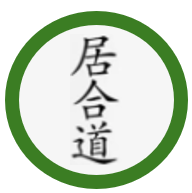10. JUPPON ME 十本目
SHI HO GIRI 四方切り
Four direction cutting
You encounter four enemies who intend to attack you. Forestall the first by using a Tsuka Ate strike to their right hand at the right diagonal front. Then thrust into the solar plexus of the next opponent at your left diagonal rear. Continue to vertically cut down the other three by turning 180 degrees to your right, then 90 degrees to your right and finally 180 degrees to your left.
a] Take two steps forward beginning with your right foot. As soon as the left foot steps forward, turn and look to the opponent at your right diagonal front and quickly grip the Tsuka with both hands. Push out the sword without drawing the blade and strike the opponent's right hand with the flat part of the Tsuka as you move your right foot forward followed by the left. The sword must finish on a horizontal level.

b] Immediately do Sayabiki with your left hand and turn to the opponent at your left diagonal rear. When the tip of the sword comes out from the Koiguchi make a left turn and take Hitoemi (l) position. Place the back of the sword behind the Monouchi on the left side of your chest. Without pausing move your left foot forward and push the left hand inwards to the navel. Stretch your right elbow and thrust the sword into the solar plexus of the second opponent's body. When you put the ridge of the sword on your chest and when you thrust your sword into the opponent, your upper body should take the same posture as Tsuka Ate.
(1) When you assume the Hitoemi position, your upper body should open further to the side than Hanmi No Kamae (side facing posture).
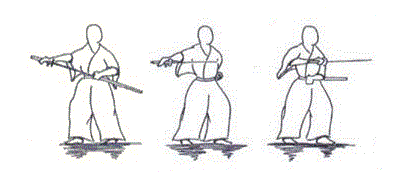
c] Now turn again towards the first opponent at your right diagonal front. Bring the sword above your head as you draw it out of the second opponent. Take hold of the Tsuka with the left hand and turn right by using your right foot as an axis to face the first opponent. Step forward with the left foot and cut them in a vertically downwards action. This Furi Kaburi action should be done smoothly and in one action.
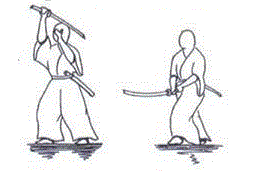
d] Turn 90 degrees next to the opponent at your right diagonal side. With the feeling of parrying an attempted sword cut, use your left foot as an axis to turn and with your right foot stepping forward, make a vertical downwards cut to the horizontal.
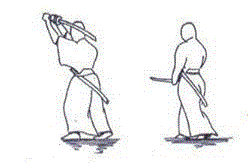
e] While turning around to face the last opponent behind at the left diagonal front, lower the point of your sword to just below your knee height and turn 180 degrees to the left, using the right foot as an axis. Move your left foot to the left and face the opponent looking side on whilst passing through the Waki Gamae position without stopping. With the feeling of parrying an attack bring your sword above your head and as the right foot steps forward, cut vertically in a downwards action to the horizontal position.
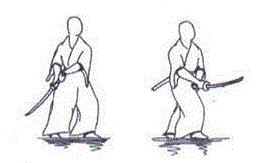
● The last point concerns precisely the question of taking Waki Gamae before cutting the last opponent.
● There has long been, and continues to be, the irresistible tendency of most people to lower the Kissaki at the moment the body pivots, and in some cases, even before the body rotates.
● In reality, the Kissaki should only be lowered when the left foot takes a sideways (forward) step to the left; These two simultaneous movements bring the body into Waki Gamae.
● Furthermore, the width of this step should be small enough to align both heels, as this is the correct foot position in Waki Gamae, and to ensure that the blade of the sword remains hidden to the right of the last opponent until the cut.
● Finally, it is also mentioned that, although most people show the intention to lower the kissaki sufficiently, in most cases, this movement is not completed (for example, the kissaki is not lowered sufficiently) and therefore most people do not actually execute the kamae before making the final cut.
f] Bring your right foot back and assume Morote Hidari Jodan No Kamae position (left foot forwards, sword above the head at 45 degrees) and show Zanshin.
g] Bring your left foot back, release your left hand from the hilt and place it on the belt. At the same time do Kesa Ni Furi Oroshite No Chiburi, the same action as described in Sanpogiri.
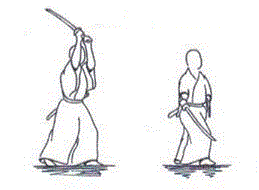
h] Release your left hand from the left belt and take hold of the Koiguchi and do Noto.
i] Bring your rear foot up in line with your front foot. Release your right hand from the Tsuka and assume Taito Shisei. Return to the starting position beginning with your left foot. It is important to have ensured correct directional cutting.
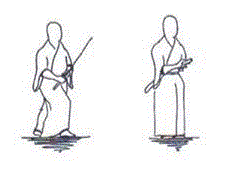
● The strike on the first opponent's hand is performed with the body slightly open to the left; unlike in Kendo where we would be facing forward. This position allows the right arm to be further away and the right wrist raised to avoid a counterattack from the opponent's Tsuka.
● When drawing the sword in preparation for the Tsuki on the second opponent, the left foot is no longer necessary to step back due to this opening of the body... everything is explained!! Don't forget to pivot on your feet.
● At the end of the drawing, the sword is positioned in the same way as in the fourth Kata.
● The Tsuki is performed by moving the left foot forward followed by the right, without turning the hips or buttocks; and the Tsuka is under the right forearm.
● The sword is extracted by pivoting on the right foot and turning the left shoulder towards the first opponent.
● The pivot towards the third opponent is different from the seventh kata, and is performed along the central axis of the body.
● To take the Waki no Kamae guard, keep the sword horizontal after the cut, while pivoting on both feet; by shifting the left foot, lower the blade to take the guard. This approach should allow for a correct guard hold.
● In making Sayabiki, is the Mune near the Monouchi of the sword on the chest and is the thrust made surely into the solar plexus of the opponent?
● When the thrust is made, is the left hand brought to the center of the navel and do both arms aid the technique with the correct tension?
● Is the final cut made by going through Waki Gamae without hesitation or pause?
